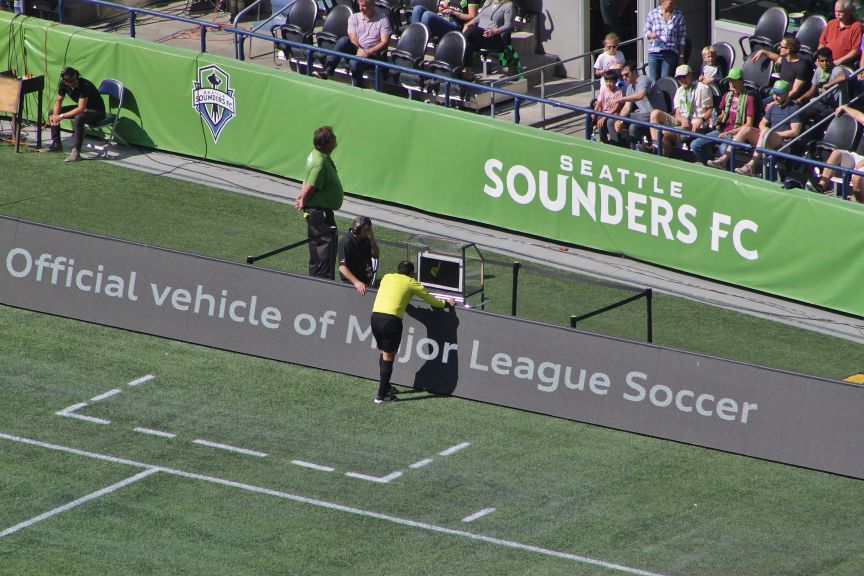By Max Kilham
V-A-R. From one week to another these simple consecutive letters cause polar opposites for fans across Europe. Either complete and utter misery, or pure elation.
The system, which has been put in place in the Premier League for the 2019-20 season, has seemed to cause more problems than solutions, despite its intended purpose of solving some of the biggest decisions in football. VAR (Video Assistant Referee) is a system used within football that aids the referee’s on the field in their decision making for crucial decisions. It looks to spot referees mistakes and correct them. For example, this may be for incorrect issuing of a red card, or a wrongly-awarded penalty. It is an operation for the long-term: a technological system that will experience a multitude of trial and error situations before becoming the device all football fans hope it to be.
However, the trial period for a system with magnitude of VAR has a certain shelf-life, which is impossible to predict. Last weekend, VAR suffered possibly its worst weekend to date in the Premier League: Manchester United vs Liverpool featured a goal for the home side that began after a debatable non-call after United’s Victor Lindelof made contact with the calf of Liverpool’s Divock Origi to start the goalscoring break. Right or wrong, the decision was not overturned. Tottenham vs Watford featured a Dele Alli equaliser which was apparently ruled out by VAR on the screen inside the Tottenham Hotspur Stadium, but was in fact awarded to the North London team. In the same game, Gerard Deulofeu of Watford was seemingly obviously tripped by Spurs’ Jan Vetonghen in the Tottenham box. The decision on the field was no penalty and the call was not overturned by VAR.
There have also been broader issues with the technology itself. Earlier in the season, a goal from Manchester City’s Raheem Sterling was ruled out for offside against West Ham. The Mail on Sunday subsequently reported that Sterling was 2.4cm offside, but that the decision was made with a 13cm margin of error, it may even have been larger; as much as 38.8cm. These decisions, and the flaws with the system itself, have placed the whole VAR process into disrepute. Scrutiny of the newly-introduced system has heightened, with the failure to correct obvious mistakes and the lack of support for the referees on the field of play.
What we must not lose sight of is the subjective nature of refereeing. Whether technology has been introduced or not, decisions are still being made by human beings, meaning subjective choice cannot be avoided. However, there are multiple issues at hand with the system, with two prominent issues coming to the fore at the start of the season. The first being various calls seemingly needing ridiculous amounts of concrete evidence to overturn a call, and the confusion that the system causes for fans inside the stadium and at home, due to a lack of clear communication between the referees on the field, the referees operating VAR, and the fans themselves. The third is that the margin of error for offside calls may often be greater than the actual amount a player is offside. The subjective nature of decisions means the preliminary focus should be to address the issue of confusion.
One option has been suggested across the board by pundits and fans alike, which has been used before in other competitions but not in the Premier League. It would provide much needed clarity for the fans and the ability for the referee on the pitch to exercise their authority on the games. This is of course a referral to a replay on the side of the pitch, which the referee on the pitch would be able to view for themselves before making extremely tough decisions in high-pressure scenarios. We have seen the implementation of this action before: at the Men’s World Cup 2018, the Women’s World Cup 2019 and from the quarter-finals stage onwards in the Men’s Champions League during the 2018-19 season.
Unfortunately, this element has not been made available this year in the Premier League this season. As a result, clarity has become a severely lacking component of the system. Confusion for fans, commentators and casual viewers has massively damaged the case for VAR, potentially reducing its chances of being included within football in the Premier League for the future. An ‘Assistant’ to the referee should provide ‘assistance’ to the referee on the pitch, the commentators, and the fans, during football games, rather than bewildering uncertainty. For now, we may have to accept the shortcomings of VAR in its early stages within the Premier League and across Europe. Patience is needed with the technology.

